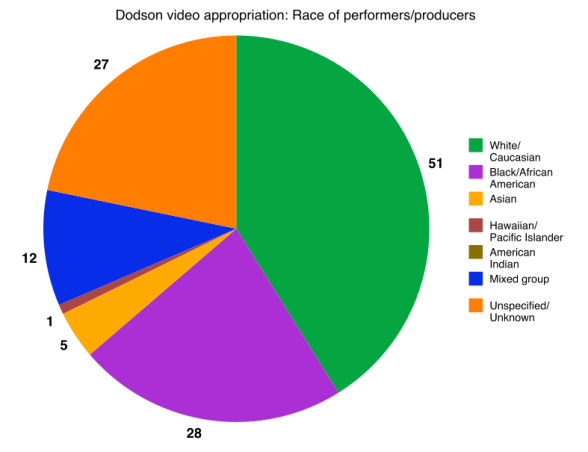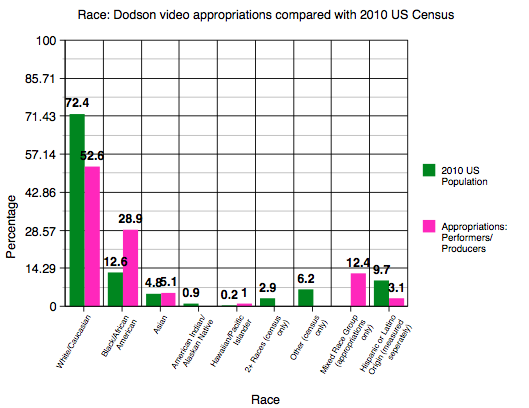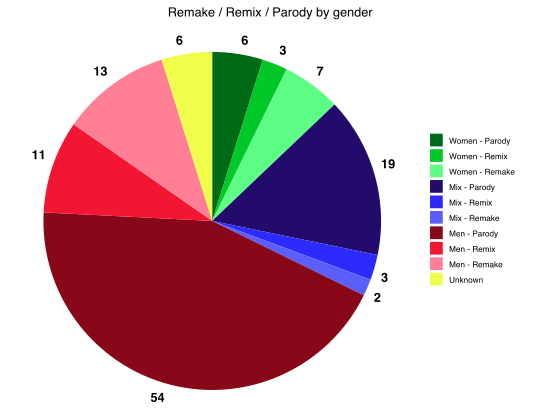Liminalities 10.3/4 (2014)
ISSN: 1557-2953
On July 29, 2010, a local television channel (NBC affiliate WAFF-48) aired a live news story about an attempted rape in Huntsville, Alabama. The story included an interview with claimant Kelly Dodson, who curtly told the reporter that she “was attacked by some idiot from out here in the projects” (CrazyLaughAction). Following this, the story focuses on Kelly’s brother, Antoine Dodson. YouTube user CrazyLaughAction uploaded the Dodson news footage onto YouTube several hours after the live airing.
(Above: Video edit [Michalik 2012] of the Dodson news story.)
The video quickly went viral. Later that night YouTube users began to upload remakes and parodies of the Dodson video, including many videos that emphasized Dodson’s impassioned interview. According to YouTube, one of the earliest appropriations of the Dodson video, the “Bed Intruder Song” by The Gregory Brothers, was the most viewed viral video of 2010. The “Bed Intruder Song” also made it onto the Billboard top 100 in August 2010 (Peters), and was remade, remixed, and parodied numerous times. Below is an excerpt (ed. Michalik 2012) from the “Bed Intruder Song” and music video by the Gregory Brothers.
(Watch the whole video on the Gregory Brothers website: http://www.thegregorybrothers.com/videos/)
The widespread practice of appropriating viral video texts, as evident in the case of the Dodson news video, suggests that viral videos have significant cultural implications. According to John Fiske, popular culture “is made by various formations of subordinated or disempowered people out of the resources, both discursive and material, that are provided by the social system that disempowers them” (Reading 2). In other words, we use popular culture texts both to make sense out of and to make culture, and text appropriation is one way we do this. While some viral video text appropriations might be an attempted means toward an economic end (e.g. The Gregory Brothers songs), many others seem to be creative acts with no intended financial goals. These texts, created in response to viral videos, are popular culture goods–a form of cultural capital. Further, as seen in the case of the Gregory Brothers video (among others), appropriations of viral videos can also become popular culture goods themselves.
Fiske posits that derivative texts exist in relation to other texts and current power structures, resisting or proliferating social structures of dominance and subordination. By creating a derivative text, the spectator-turned- producer is navigating and/or negotiating his place within complex social power structures, regardless of his or her intentions. In this study I use Henry Jenkins’ notion of participatory culture to consider viral video spectators as people who do something interactive, beyond watching and forwarding a video: spectators-turned-producers who appropriate the viral video to create a derivative video text. Like all texts, viral videos and their appropriations make cultural statements with varying degrees of efficacy. Regardless of the efficacy of the individual videos, prevailing motifs and aesthetic commonalities among the appropriations of a single viral video text might indicate what consumer-producers specifically value and/or oppose in the original video.
Through a comparative analysis of 124 video appropriations of “Antoine Dodson warns a PERP on LIVE TV!” (CrazyLaughAction), I show how these video appropriations perpetuate and subvert racial, class, and gender stereotypes. I compare various ways people have appropriated the Dodson video to challenge or re-inscribe various stereotypes and ideologies, and argue that parody seems to be the most efficient, effective, and accessible way to appropriate a viral video text for cultural commentary. Further, patterns among the Dodson video appropriations reveal that parodies of this particular video, when viewed as a means of critical engagement through YouTube, favor masculine narratives and ideologies. I conclude by stating that additional research on viral video appropriation trends might further reveal how YouTube works as a potential space for a democratized, participatory media culture and (at the same time) as a space for the re-inscription of racial, class, and gender stereotyping. I suggest that a critical, performative methodology can engage in (or spur) dialogue about these issues on their home turf (i.e. outside of academia and on multimedia platforms), and that the construction of further parodies and remixes that offer new voices, readings, and interpretations could shake up the status quo. This piece is an example of such a methodology, as I offer my own research and interpretations, meanwhile performatively collaging other voices and multiple media so that they might work dialogically for the reader/viewer, prompting him or her to ask further questions and construct new meanings.
Rapid Symbiosis: The viral video and participatory culture
More than 24 hours of video is uploaded onto YouTube every minute, and “tens of thousands” of the “hundreds of thousands” of YouTube users create and upload videos (“Frequently Asked Questions”). This uploading, especially when it is a response to or an appropriation of an existing text, can be thought of in terms of Henry Jenkins (2006) notion of participatory media culture. Briefly, in a participatory media culture we communicate with each other by creating or re-using media in/as dialogue, and in doing so we are also shaping and changing culture.
Web 2.0 users are by definition also producers. On a daily basis, Web 2.0 users interpret, alter, and adapt popular culture texts on social media sites. Through social media, the process of adaptation is also transforming from the more culturally sanctioned, corporate driven novel-to-movie (or vice-versa, or similar) format, to the quicker, cheaper, frenetic, user-friendly, and socially-invited formats that include short videos and images (memes). This study uses close readings of a number of adaptations of the single “original” Dodson text to show the complex ways that just one news story has been appropriated on just one website: YouTube.
As appropriation can take a variety of forms, I will define the three types of viral video appropriations I consider in this study: remakes, remixes, and parodies. I will then explore how these types of appropriations function in different ways as cultural commentary.
I split the videos into the following categories:
1. Remake: Appropriated with little or no change to the form or content of the original (i.e. shot-for-shot remakes & impersonations). Broadly, remakes can differ widely in terms of how alike they are to the to the texts they appropriate. For example, the characters in Scarface (1932) were involved in illegal alcohol trading, whereas the characters in the 1983 remake of the film dealt in cocaine smuggling. Conversely, Gus Van Sant remade Alfred Hitchcock’s Psycho using a shot-for-shot visual technique. Other than the film actors, Van Sant’s Psycho is almost completely visually identical to Hitchcock’s. Like Van Sant’s Psycho, for the purposes of this study I am defining the remake as a text that is appropriated with little or no changes to the form or content of the original. This would include shot-for-shot remakes, impersonations, and imitations of all or part of the original video. Of course, re-performance of a video will always be different from the original performance in some way. I am, however, looking at these remakes as mimesis, or as an attempt to imitate or mirror the original video as closely as possible. As the creators of these video remakes re-perform the video they viewed, they offer little to no explicit cultural commentary that deviates from the original. Instead, these remakes further disseminate the explicit or implicit messages and ideologies in the original video.
2. Remix: Appropriations that take the original text and rearrange it, combine and/or recontextualize fragments, and offer an alternate version of the text. I am defining “remixes” as video appropriations that take the original text and rearrange it, combine and/or recontextualize fragments, and offer an alternate version of the text. Remixing can be compared to the process of “redaction,” “the production of new material by the process of editing existing content” (Hartley 112). As video remixes do not simply re-perform the original text like remakes do, remixes are less likely to physically reveal their producer. Also, because they interpret and alter the original text, remixes offer a somewhat wider range of explicit and implicit cultural commentary, from the celebratory to the incendiary. For example, The Gregory Brothers “Bed Intruder Song” is a remix of the Dodson video that quickly became more popular than the original video,* arguably contributing to the original video’s popularity.
*Side Note: The Gregory Brothers Process of Songification
The Gregory Brothers uploaded their musical remix of the Dodson video onto YouTube two days after the original video aired, as part of their popular “Auto Tune the News” video series. The brothers created “Auto Tune the News” videos through a process they call songification. To songify a video, they scavenge through current news footage for interesting stories and “accidental singers,” or people who speak with passionate pitch variation and whose voices have a natural musical quality (Sirucek, 2010). Next they filter the audio of the selected news footage through an auto tune vocorder, a device that disguises singers’ off-key inaccuracies and creates perfectly tuned vocal tracks. Auto tuning the speaking voices of “accidental singers” thus produces song-like results. To complete the process, they cut and remix the songified news footage to create a structured song with verses and a chorus. With Antoine Dodson’s permission, the Gregory Brothers songified Dodson’s voice, remixed the original Dodson video footage, and spliced in several shots of themselves to create the “Bed Intruder Song” and music video.
3. Parody: Appropriations that have explicitly changed the form and/or content of the original. Parodies generally offer the most explicit (and often most powerful) cultural commentary.
There are an array of theories about the purpose and value of parody, and this study builds on two theories about parody that embrace its polyvocal qualities. Mikhail Bakhtin asserts that parodic texts date back to ancient history, and that these texts were just as relevant and respected as the texts they parodied. Parody was a natural inclusion in the life cycle of the text. The satyr play, for example, was the “fourth drama” that followed a tragic trilogy, and used the same narrative and mythological motifs (54). Parodic texts were not seen as profane or blasphemous, and authorship was proudly claimed. The purpose of a parody was to provide laughter and critique for existing straightforward genres and styles, allowing (or “forcing”) its audience to experience multiple sides of a text (59). Parodies of the Dodson video, considered in these terms, would allow us to see the various forces at work in the original video, including the television news genre, the viral video genre, and the performances within the video.
Linda Hutcheon theorizes that postmodern parody is a form of interpretation that is used to make fun of a text. In making fun, the producer of the parody is asserting his or her position in regards to the original text. Parody is always political, exposing power structures, cultural trends, and ideologies. Hutcheon further states “parody is doubly coded in political terms: it both legitimizes and subverts that which it parodies” (101). Yet, while parody “may indeed be complicitous with the values it inscribes as well as subverts… the subversion is still there” (106). Studying various parodies of a viral video in this sense would reveal what narratives and ideologies are being maintained and/or subverted, and how people are using parody to achieve these ends.
For the purposes of this study, “parody” specifically refers to appropriated texts that have explicitly changed the form and/or content of the original. Combining Bakhtin’s and Hutcheon’s theories, I am defining parody as the creative appropriation of a text that in some way acknowledges the complex set of forces at work in the parodied text. By adapting the text to celebrate and/or critique it, a parody asserts its producer’s position in relation to the original text.
Why Dodson? “Well, obviously…”: Base text selection process
I chose the Dodson video out of many possible viral videos for several reasons. The Dodson video had over 37 million views on YouTube by September 2011, and it was the most viewed News/Politics video on YouTube in 2010. According to Fiske, popular culture made out of television news broadcasts must be made out of–not by–the news. In line with this, the Dodson video was not uploaded to YouTube by its original broadcasting source. News texts will also only be made popular if they offer meanings relevant to subordinate people (Fiske, Reading, 3). This implies that the Dodson video contained ideologies, messages, and/or performances that were relevant to current social power structures.
I recognize that I have chosen a video to use as a base text that is not necessarily representative of all viral videos on YouTube. Due to the number and nature of viral videos, it is doubtful that a single video exists that could stand on its own as a representation of all viral videos. At the same time, the overwhelming popularity of both the original Dodson video and many of its appropriations suggests that this text would, at the very least, do a better job at representing the viral video genre for this type of study. Further, because of the time-sensitive nature of the viral video, studying appropriations of a more recent text is useful in terms of identifying current power structures, trends in the viral video genre, and the various ways people are using YouTube and viral video appropriation for cultural commentary.
By limiting my searches to YouTube videos I have neglected other video-sharing websites and potential appropriations that are created using other media. YouTube is the platform where the Dodson video first appeared online, and it is one of the largest and most popular video-sharing communities on the Internet. Further, videos are often shared between YouTube and other online video-sharing communities. Additionally, many of the Dodson appropriations incorporate music and/or still images. Some producers are combining media in their video appropriations, while others are using the video format to upload appropriations that only include audio and/or still-images. Thus while I am limiting my study to one file-sharing platform, the flexibility in terms of what media can be used to make a YouTube video allows me to study appropriations in a variety of media formats. These choices keep this study manageable in size, yet widens the scope of previous research (Gurney 2011; Willett 2008) that has been conducted on viral video appropriations, and builds upon this research in new ways.
“Dodson” Search Trends
The following graphs show Google search trends for the phrases “antoine dodson” and “bed intruder” in 2010 and 2011 (“Google Insights for Search”).
“The numbers on the graph reflect how many searches have been done for a particular term, relative to the total number of searches done on Google over time. They don’t represent absolute search volume numbers, because the data is normalized and presented on a scale from 0-100. Each point on the graph is divided by the highest point, or 100. When we don’t have enough data, 0 is shown. The numbers next to the search terms… are summaries, or totals.” (“Analyzing Data”)
2010
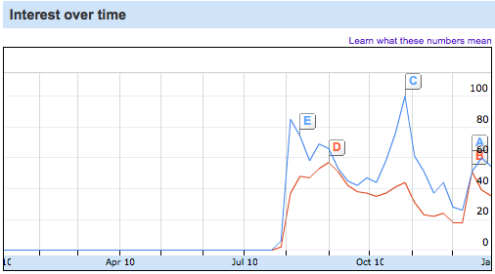

2011
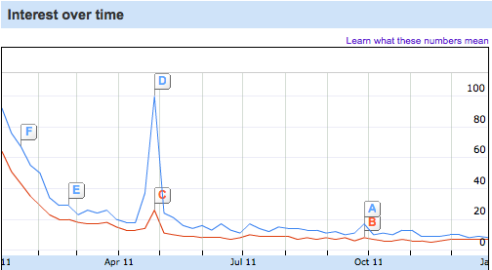

(For more information on Google search trends, including different search terms, date ranges, interest by city or region, and top searches, you can visit “Google Insights for Search” at: http://goo.gl/qFh5f)
“Lookin’ for you”: Selection and analysis of video appropriations
My process to determine which appropriations to analyze began with a YouTube search of “antoine dodson parody.” I chose this phrase because it brought up videos that were relevant to Antoine Dodson, but generally left out news, interviews, and other television appearances Dodson made after the original video went viral. This search brought up 642 results. Of these results I analyzed the top 50 that YouTube offered when sorted by most relevant (YouTube’s default sorting method at the time). I then resorted the videos on YouTube and analyzed the top 50 most recent, top 50 most viewed, and top 50 highest rated. I wanted to select a sample of videos that would be most representative of the videos others might watch if they conducted the same search. By resorting the videos, I allowed for variety in terms of what people might look for (relevant videos, newer videos, or popular videos). Some videos came up in more than one of my searches. After removing duplicates, I was left with 124 unique videos.
When analyzing the videos I collected the following data, provided by YouTube statistics: the date the video was posted, the length of the video, the number of views, how many other videos the user had posted, the user’s total number of channel views, the total number of upload views (for all videos), and the number of subscribers the user had. I also recorded the age, gender, and race of the users when this information was provided. I analyzed each video in terms of:
1. Video quality (i.e. audio-visual clarity and how technologically skilled the producer seemed).
2. The elements of the text that were appropriated from the original Dodson video.
3. How the text was altered in the appropriation.
4. If the appropriation was a remake, remix, or parody.
5. Whether text was appropriated from the original Dodson video, the “Bed Intruder” song, or both.
6. What cultural commentary the user might be intentionally or unintentionally making with his or her video.
“Run and tell that”: Appropriation production patterns in terms of “who” and “how”
Of the 124 Dodson video appropriations I studied, most videos were performed and/or produced by white/Caucasians, followed by black/African Americans, and then groups that included people of multiple/different races. Twenty-seven of the videos I studied were made by individuals or groups whose race could not be determined by the information provided on YouTube. The chart below shows the breakdown of performers/producers by race.
When compared to the racial make up of the US as reported in the 2010 US Census, the greatest differences this study shows are that comparatively fewer white/Caucasians and comparatively more black/African Americans performed in and produced Dodson video appropriations. The chart below shows the breakdown of performers/producers by race in comparison with the 2010 US Census figures.
In terms of gender, the study revealed distinct differences in the frequency and style of appropriations made by men and women producers. Briefly, men made more videos than women. Men also more often made parodies, while women generally created remakes and remixes.
As a default setting, YouTube searches contain 20 results per page. When sorted by “most relevant,” the first video made by a woman was ranked 21st, and thus located on the second page of results. When sorted by “most recent” and “most viewed” only one video in the top 20 for each sorting method was made by and/or starring a woman. When sorted by “highest rated,” the first video made by and starring a woman was ranked 42nd (found on p. 3 of the search results). The adjacent chart shows the number of remakes, remixes, and parodies that starred women only, men only, and a combination of women and men. “Unknown” includes remakes and remixes in which the gender of the producer/performer is not supplied on their YouTube user profile.
Below: Video remix of various Dodson remakes, remixes, and parodies (ed. Michalik 2012)
Close readings of the derivative videos along with an analysis of the similarities and differences among these videos can provide “valuable clues to the readings that a particular culture or subculture is likely to produce” (Fiske 108). Fiske theorizes that while the meaning of a text can be hard to pin down, we might address this by “shift[ing] our focus from the text to its moments of reading” (117). In other words, studying how people are appropriating (and by extension “reading”) the Dodson video within specific social and historical constructs would prove more fruitful than analyzing the Dodson video on its own to determine its possible meanings. Also, trends among the appropriation of a single base text should reveal larger underlying values and power structures that are being propagated or challenged.
I thus analyzed the derivative videos as individual texts in terms of their “vertical intertextuality,” or their relations to the original, and their “horizontal intertextuality,” or their potential relations to each other (117). Of course, my interpretations of what cultural commentary the videos might be making on their own and/or in relation to each other are undoubtedly affected by my own experiences and personal subjectivity. At the same time, taking note of common trends and motifs among the videos (particularly specific attempts at reproducing or changing the original visual or spoken text) should reveal on a larger scale how people are using the Dodson video, regardless of what I interpret these videos to be implicitly or explicitly saying.
“Leaving behind evidence”: Dominant motifs
Popular culture texts offer space for excess in appropriation, like “parody, subversion [and] inversion” (Fiske, Reading, 6). These excessive forms of performance make statements and create new meanings beyond those that might be inferred from the original text, and can thus be used to communicate their producer’s position within and beliefs about existing power structures. The Dodson video readily lends itself to these excessive performances in a variety of ways, especially in terms of stereotypical race, socioeconomic class, gender, and sexuality performances. In the original video, a white news reporter is interviewing a black family (Antoine and Kelly Dodson). At the time of the interview, the Dodsons were poor; according to Kelly Dodson, they lived “in the projects” (CrazyLaughAction). While Antoine Dodson is introduced as a man/male, he combines traditionally masculine speech patterns (straight forward, dominant, attention- commanding, and controlling language) with traditionally feminine vocal and physical performances (verbose and emotional). Additionally, after months of rumors, in October 2010 Antoine Dodson publicly announced that he is gay (Irin). (Note: In 2014, Dodson retracted this statement.)
The most common motifs among the Dodson video appropriations included racial and class stereotypes, and these often occurred simultaneously. Many parodies (regardless of the race of the producer/s) exaggerated the amount of things the perpetrator left on the scene to address these stereotypes. In addition to the t-shirt that Dodson mentions in the original video, appropriations included items like fried chicken, watermelon, and teeth.
(Above: Video compilation of parodies that exaggerate things to hide and/or the evidence the intruder left at the crime scene [ed. Michalik 2012].)
Out of the 124 videos there were five explicit incidents of man-to-woman cross-dressing. This was often a man performing as Kelly Dodson or the woman interviewer. There were 16 explicit incidents of woman-to-man cross-dressing, and in all of these a woman dressed and performed as Antoine Dodson. Only one video included both man-to-woman and woman-to-man cross-dressing. The videos made by men that included Kelly Dodson or the woman reporter generally used women performers to play these minor roles. Several videos made by men incorporated a male reporter. Overall, most of the videos made by men cut the roles of Kelly Dodson and the reporter out altogether, so their remake, remix, or parody only included Antoine Dodson.
While men did not often cross-dress in the videos to address gender stereotypes, many of the remakes and parodies featured men attempting to exaggerate the femininity of Dodson’s performance. Whether these performances were attempts to celebrate or to mock Dodson’s hybridized gender performance is often unclear. Regardless of the performers’ intentions, most of these videos work on multiple levels, simultaneously making fun of and having fun exploring traditional gender stereotypes. In contrast, the women that perform as Dodson (especially in the remakes) seem to be more openly celebrating Dodson’s comfort with his own gender hybridization, and his breaking of the gender binary. These women speak Dodson’s dialogue, often word for word, stressing how Dodson simultaneously expresses his physical femininity along with his traditionally (active, powerful, attention-commanding) masculine message, “You don’t have to come and confess that you did it. We’re looking for you. We, we gon’ find you, I’m letting you know now. So you can run and tell that, homeboy” (CrazyLaughAction).
Several parodies were overtly homophobic. The most striking of these videos features the comedian Donnell Rawlings, as seen in the following video. In a parody of the “Bed Intruder Song,” Rawlings plays the accused perpetrator. A censor bar intentionally ineffectively conceals his identity as he addresses his audience (assumedly Dodson). Below is an excerpt from “Donnell Rawlings Aka Ashy Larry – Bed Intruder Response Song” (ed. Michalik 2012).
(Watch the full video–hosted on metacafe–here: http://goo.gl/ApCen)
By December 2010 many appropriations were dropping or changing the word “rape.” Below is an excerpt from Liberty University’s “Carol of the Bed Intruder” (ed. Michalik 2012).
(Watch Liberty University’s concert video and read an explanation about how this appropriation went viral on Liberty University’s “News and Events” website: http://www.liberty.edu/index.cfm?PID=18495&MID=24615)
Producers also changed the crime to address other issues, and/or appropriated Dodson’s character into different contexts. These alternate crimes and contexts included car accidents, ninja attacks, various robberies, a variety of Christmas themed videos, a fraternity party, Michael Jackson’s “Thriller” music video, and a workout video.
One video removed the issue of rape, seemingly in an attempt to more directly address racial and class stereotyping. The video stars an older white man who sits in a chair in a fancy house, holding a glass of champagne. The man names his character (as seen in the video’s title) “Antoine Dodson The Rich White Racist” (oshacueru). His blatant self-labeling as racist, tongue-in-cheek monologue, evil laughter, and over-the-top performance all suggest that rather than supporting racial and class stereotypes, this man is attempting to subvert these stereotypes by calling attention to their absurdity.
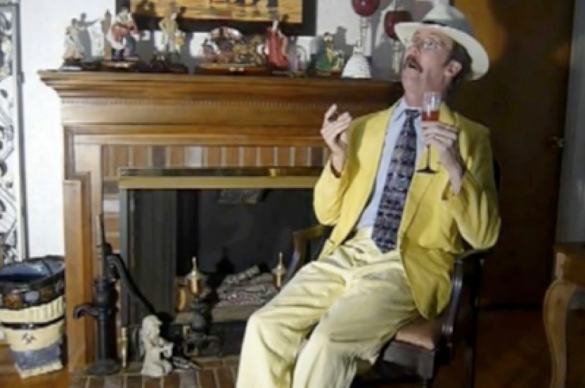 (Above: Screen shot of “Antoine Dodson the Rich White Racist” [oshacueru])
(Above: Screen shot of “Antoine Dodson the Rich White Racist” [oshacueru])
“Obviously we have a black man intruding here on the grounds of the Hamptons. Obviously the black man doesn’t hold a degree from an Ivy League institution of higher learning. He left fried chicken bones and watermelon rinds in the pool. Why would a black man be in a swimming pool? Everyone knows they can’t swim. (Evil laughter.) Perhaps he was there to clean the pool.” (oshacueru)
Vlog vs. Parody: Addressing style and efficacy
In contrast to the remakes, remixes, and parodies that many of the women producers made, one video came up in my search that took a very different stylistic approach. In a long (13:52) vlog, a younger black woman reads a poem she wrote and dedicated to Antoine Dodson. She talks about celebrity and commercialism, stating “We are not doing things for success, we are only doing things for money” (MsVictoriaShantrelle). She asks, “What does it profit a man to make a few dollars and lose his integrity?” and speaks passionately (but calmly) about cultural insensitivity and the social and historical implications of what Dodson is promoting (in her opinion): a “gay, ghetto, uneducated, poor, black man” being mocked and laughed at. She says to Dodson, “Somebody gave you some money to coon,” and warns him that he is perpetuating the message that self-degradation is an appropriate way to make money. She adds, “Other people are making money off your self degradation,” and ultimately says the questions we should really be asking are, “Why has our society failed this man? Why was he living in the projects?” Her cultural commentary is frank, and she states that the intent of her video was not only to address Dodson, but also to initiate a dialogue about these issues between races. She gives a number of different ways for Dodson and others to contact her. (You can watch MsVictoriaShantrelle’s entire video, “The Disturbing Case of Antoine Dodson” on her YouTube channel here: http://tinyurl.com/7romfgf)
The parody video “Antoine Dodson discusses his new show based on Bed Intruder” addresses many of the same issues: celebrity, commercialism, performance, and self-degradation for money (“BarrettTV”). In this video a black man plays Dodson and a black woman plays Kelly. Both performers appear to be in their 20s. They stand outside of an apartment complex as the video begins with a remake of the news footage. Below is an excerpt from “Antoine Dodson discusses his new show based on Bed Intruder” by BarrettTV (ed. Michalik 2012).
(Watch the whole video on BarrettTV’s YouTube channel here: http://www.youtube.com/user/BarrettTV)
Shortly after this point in BarrettTV’s video, music kicks in and the two performers begin lip-syncing and dancing, making an impromptu music video for the “Bed Intruder Song.” The entire video is less than three minutes long.
I bring up these two videos together to address the efficacy of different forms of cultural critique on YouTube. These videos came up in the same search and convey similar messages and ideological positions. While the vlog has a serious tone throughout, is much longer, and has 1,174 views (including 15 likes and 4 dislikes), the second video takes a comedic/parodic approach, is quite short (like most viral videos), and has 22,275 views (including 147 likes and 75 dislikes). The two producers define themselves similarly in their user profiles: “Media Personality, Producer, and Talk Show Host” (MsVictoriaShantrelle) and “Media Mogul” (BarrettTV). The vlog was posted 3 months after the parody (at which point the parody already had about 10,000 views) but according to YouTube statistics, both videos plateau in views around mid-January 2011. In the same period of time (Nov. 2010 to Jan. 2011), by March 2011, the parody had been viewed 10 times more often than the vlog.
Burgess and Green state that the vlog form of YouTube video “more than any other form… invites critique, debate and discussion” (54). Yet the comparison of the two previously mentioned videos suggests that there is something about parodic appropriation (when created as a response to a viral video) that increases the likelihood of a larger audience, and in turn a greater potential for further dialogue about the parodied text. Parody also generally seems to attract larger audiences, and thus may be a more powerful means for a video producer to assert his or her message, when compared to other video response formats (including remakes, remixes, and vlogs). Of course, it would also be beneficial to consider the efficacy of these forms and the types of responses they invite on a case-by-case basis. (For example, a vlog might elicit other vlog responses or written comments, while a viral video might invite a wider range of video response forms.)
Conclusion
According to Burgess & Green, “it is the participants in YouTube’s social network who are producing much of YouTube’s cultural, social, and economic value” (98). Through an analysis of various appropriations of the viral video “Antoine Dodson warns a PERP on LIVE TV!” this study revealed some of the complex ways that viral video appropriations (including remakes, remixes, and parodies) produce cultural and social value while simultaneously perpetuating and/or subverting racial, gender, and class stereotypes. While all viral video appropriations contribute some level of cultural commentary, the parodic Dodson appropriations seem to be the most widely viewed and the most powerful of the three considered forms, in terms of cultural impact.
Recent research (Gurney 2011; Willett 2008) has analyzed individual viral video texts, a small number of viral video appropriations, viral video comments, and individual video parodies on YouTube to study culture, personal identity, and the viral video genre. To add to this emergent body of knowledge, studies on the vertical and horizontal intertextuality of larger numbers of viral video text appropriations can reveal how individuals and various communities might be reading/interpreting viral videos. Such research can also address how people are currently using viral videos – or more importantly, using current viral videos – to navigate and/or negotiate their place/s within complex social power structures. Many digital archives include easily accessible and up-to-the-minute (or hour) information. YouTube and Google both offer data collection and information storage systems which would allow for the study of video trends both while the trends are happening and after the fact. Websites like “Know Your Meme” track viral meme patterns more broadly (including when, how, and at what rate memes are disseminated), on a variety of social networking sites as patterns appear and evolve. These resources open the door for research that might further illuminate social and cultural patterns during the early stages of a video’s virality. A comparative analysis that takes into account the time and date that the selected video appropriations were uploaded, for example (which was beyond the scope of this study), could better explore the appropriated texts’ horizontal intertextuality, and how these videos might be contributing to larger cultural patterns.
Case studies that incorporate intertextual readings can shed light on the types of texts that currently invite/inspire public adaptation, along with the types of adaptations that are currently popular. This type of research will allow us insight into possible cultural and social implications of popular, public adaptation trends. This study, for example, shows the complex ways that a single news story has been appropriated by a variety of Web 2.0 users on just one online platform, and how these adaptations might work to subvert and/or perpetuate racial, class, and gender stereotypes. Further research into this type of popular/public adaptation could pave the way toward theories of adaptation that take into account not only popular culture (Jenkins 2006; Hutcheon 2006), but also the interests, values, and concerns of various publics.
References
AfricanoBoiShow. “Woman wakes up to find intruder in her bed(SPOOF).” YouTube. 2 Aug. 2010. Web. 22 Mar. 2012. Video file.
Aisle3Productions. “Bed Intruder Grandma.” YouTube. 20 Aug. 2010. Web. 22 June 2012. Video file.
all4him72. “Antoine Dodson Charlise 6 y.o. impersonation.” YouTube. 1 Jan. 2011. Web. 15 Mar. 2012. Video file.
Angelasateriale. “Bed Intruder – Antoine Dodson” YouTube. 27 Jan. 2011. Web. 23 Mar. 2011. Video file.
Bakhtin, M. M. The Dialogic Imagination: Four Essays. Austin: U of Texas P, 1981. Print.
BarrettTV. “Antoine Dodson discusses his new show based on Bed Intruder.” YouTube. 27 Aug. 2010. Web. 3 Apr. 2011. Video file.
Burgess, Jean. & Joshua Green. YouTube: Digital Media and Society Series. Cambridge: Polity, 2009. Print.
CheyenneTechno. “The CHIMNEY INTRUDER!” YouTube. 12 Dec. 2010. Web. 23. March 2011. Video file.
CrazyLaughAction. “Antoine Dodson warns a PERP on LIVE TV!!! (Original).” YouTube. 29 July 2010. Web. 22 June 2012. Video file.
crazyseniorcitizen. “old man wakes up to find intruder in bed.” YouTube. 4 Sept. 2010. Web. 22 Mar. 2011. Video file.
DJinfamousRose. “BED INTRUDER SONG BABY.” YouTube. 4 Nov. 2010. Web. 22 June 2012. Video file.
Fiske, John. Reading the Popular. London: Routledge, 1989. Print.
—. Television Culture. Padstow: T J Press, 1987. Print.
“Frequently Asked Questions.” YouTube. 2011. Web. 2 April 2011.
GrungeVegan93. “Antoine Dogson.” YouTube. 31 Aug. 2010 Web. 15 Mar. 2012. Video file.
Gurney, David. ““It’s just like a mini-mall”: Textuality and participatory culture onYouTube.” Flow TV: Television in the age of media onvergence. ed. Michael Kackmanet. New York: Routledge, 2011. Kindle.
Hartley, John. Television Truths: Forms of Knowledge in Popular Culture. London:Blackwell, 2008. Print.
Hutcheon, Linda. The Politics of Postmodernism. New York: Routledge, 1989. Print.
—. A Theory of Adaptation. New York: Taylor and Francis, 2006. Kindle.
“Insights For Search.” Google. 2012. Web. 22 June 2012.
Irin, C. “Antoine Dodson Responds To The Haters.” Jezebel. 28 Oct. 2010. Web. 3 Apr. 2011.
JamJamBigLow. “Woman wakes up to find intruder in her bed (Antoine Dodson Spoof).” YouTube. 31 July 2010. Web. 22 March 2011. Video file.
Jenkins, Henry. Convergence Culture. New York: NYUP, 2006. Print.
—. Fans, bloggers, and gamers: exploring participatory culture. New York: NYUP, 2006. Kindle.
JustPhucket. “Antoine Dodson (WHITE BOY) Spoof.” YouTube. 20 Sept. 2010. Web. 22 June 2012. Video file.
Luvvyheart. “Antoine Dodson African Parody.” YouTube. 12 Aug. 2010. Web. 22 Mar. 2011. Video file.
McAlisterMania. “BED INTRUDER Antoine Dodson: Country Version” YouTube. 1 Aug. 2010. Web. 23 Mar. 2011. Video file.
MsVictoriaShantrell. “The Disturbing Case of Antoine Dodson” YouTube. 31 Oct. 2010. Web. 23 Mar. 2011. Video file.
Oshacueru. “ANTOINE DODSON THE RICH WHITE RACIST” YouTube. 4 Aug. 2010. Web. 22 Mar. 2011. Video file.
Peters, M. “Gregory Brothers Take Antoine Dodson to the Hot 100.” Billboard. 19 Aug. 2010. Web. 2 Apr. 2011.
PONCHO5252. “BED INTRUDER spoof.” YouTube. 11 Aug. 2010. Web. 22 June 2012. Video file.
Schmoyoho. “Auto-Tune the News: BED INTRUDER SONG!!!” YouTube. 31July 2010. Web. 22 June 2012. Video file.
ShortFunnyAsian. “Antoine Dodson – Woman wakes up to find intruder in her bed (PARODY).” YouTube. 4 Aug. 2010. Web. 22 June 2012. Video file.
Sirucek, S. “ATTI: Auto Tune the Interview.” Huffington Post. 16 July 2010. Web. 23 Mar. 2011.
SplitYourWit. “University of Memphis SGA Antoine Dodson SPOOF (Short Version).” YouTube. 27 Oct. 2010. Web. 15 Mar. 2012. Video file.
StapleNews. “The Bed Intruder Responds to Antoine Dodson’s Threats!” YouTube. 31 Aug. 2010. Web. 23 Mar. 2011. Video file.
“Table 1: Population by Hispanic or Latino Origin and by Race for the United States: 2000 and 2010.” Overview of Race and Hispanic Origin: 2010. Web. 23 Mar. 2011.
theLLEGACY. “Antoine Dodson SPOOF.” YouTube. 11 Aug. 2010. Web. 22 Mar. 2011. Video file.
whogotbeef2. “Woman wakes up to find intruder in her bed hide your kids parody.” 1 Aug. 2010. Web. 15 Mar. 2012. Video file.
Will O. et. al. “Antoine Dodson / Bed Intruder.” Know Your Meme. 2010. Web. 22 June 2012.
Willett, Rebekah. “Consumption, Production and Online Identities: Amateur spoofs on YouTube.” Play, Creativity and Digital Cultures. eds. Willett, Rebekah et. al. London: Routledge, 2008. Print.
Lyndsay Michalik (PhD, Louisiana State University) is a Visiting Assistant Professor in the Department of Cinema Studies at Oberlin College & Conservatory, where she teaches courses in Video Production, Remix Culture, Digital Adaptation, Performance and Intermediality, and Video Art. The author thanks Dr. Patricia Suchy for her guidance and insight throughout the dissertation project, of which this study was a part, as well as Dr. Michael Bowman, Dr. Rachel Hall, and all others who have reviewed this work in its various forms of mediation.
Contact:
Lyndsay Michalik, PhD
Visiting Assistant Professor
Department of Cinema Studies
Oberlin College & Conservatory
Rice Hall, Room 130
10 N. Professor St.
Oberlin, OH 44074
lmichali (at) oberlin.edu
Please cite this work as:
Michalik, Lyndsay. “How Antoine Dodson and the Bed Intruder Keep Climbin’ in our Windows: Viral Video Appropriation as Performance.” Liminalities 10.3/4 (2014)
 Unless noted otherwise, everything on this site is licensed under a
Unless noted otherwise, everything on this site is licensed under a
Creative Commons Attribution-Noncommercial-No Derivative Works 3.0 License.

